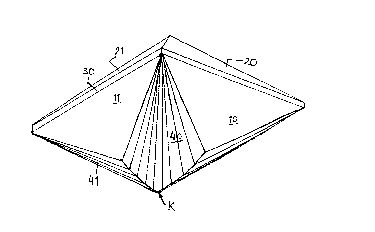Some of the information on this Web page has been provided by external sources. The Government of Canada is not responsible for the accuracy, reliability or currency of the information supplied by external sources. Users wishing to rely upon this information should consult directly with the source of the information. Content provided by external sources is not subject to official languages, privacy and accessibility requirements.
Any discrepancies in the text and image of the Claims and Abstract are due to differing posting times. Text of the Claims and Abstract are posted:
| (12) Patent Application: | (11) CA 2242616 |
|---|---|
| (54) English Title: | POLISHED GEMSTONE |
| (54) French Title: | PIERRE PRECIEUSE POLIE |
| Status: | Deemed Abandoned and Beyond the Period of Reinstatement - Pending Response to Notice of Disregarded Communication |
| (51) International Patent Classification (IPC): |
|
|---|---|
| (72) Inventors : |
|
| (73) Owners : |
|
| (71) Applicants : |
|
| (74) Agent: | MACRAE & CO. |
| (74) Associate agent: | |
| (45) Issued: | |
| (86) PCT Filing Date: | 1997-01-30 |
| (87) Open to Public Inspection: | 1997-08-21 |
| Examination requested: | 1998-07-09 |
| Availability of licence: | N/A |
| Dedicated to the Public: | N/A |
| (25) Language of filing: | English |
| Patent Cooperation Treaty (PCT): | Yes |
|---|---|
| (86) PCT Filing Number: | PCT/DE1997/000196 |
| (87) International Publication Number: | WO 1997029661 |
| (85) National Entry: | 1998-07-09 |
| (30) Application Priority Data: | ||||||
|---|---|---|---|---|---|---|
|
The cut of a gemstone is formed so as to produce between the side edges of
each lower facet a group of additional, narrow, triangular facets which fan
out from the girdle plane. The narrow surfaces of each additional facet meet,
along the lines of connection between the points of the lower facets, with the
narrow surfaces of the additional facets of the respective adjacent group.
Said cut gives the gemstone a new appearance with respect to brilliance and
brightness.
Une pierre précieuse est taillée de manière à créer entre les arêtes latérales de chaque facette inférieure un groupe de facettes additionnelles triangulaires étroites partant en éventail depuis le plan de feuilletis. Les surfaces étroites de chaque face additionnelle rencontrent, le long des lignes de jonction entre les points des facettes inférieures, les surfaces étroites des facettes additionnelles du groupe adjacent respectif. Ainsi taillée, la pierre précieuse revêt un nouvel éclat.
Note: Claims are shown in the official language in which they were submitted.
Note: Descriptions are shown in the official language in which they were submitted.

2024-08-01:As part of the Next Generation Patents (NGP) transition, the Canadian Patents Database (CPD) now contains a more detailed Event History, which replicates the Event Log of our new back-office solution.
Please note that "Inactive:" events refers to events no longer in use in our new back-office solution.
For a clearer understanding of the status of the application/patent presented on this page, the site Disclaimer , as well as the definitions for Patent , Event History , Maintenance Fee and Payment History should be consulted.
| Description | Date |
|---|---|
| Application Not Reinstated by Deadline | 2001-01-30 |
| Time Limit for Reversal Expired | 2001-01-30 |
| Deemed Abandoned - Failure to Respond to Maintenance Fee Notice | 2000-01-31 |
| Inactive: Single transfer | 1998-11-19 |
| Inactive: IPC assigned | 1998-10-22 |
| Inactive: First IPC assigned | 1998-10-22 |
| Classification Modified | 1998-10-22 |
| Inactive: Courtesy letter - Evidence | 1998-09-22 |
| Inactive: Acknowledgment of national entry - RFE | 1998-09-17 |
| Application Received - PCT | 1998-09-14 |
| Request for Examination Requirements Determined Compliant | 1998-07-09 |
| All Requirements for Examination Determined Compliant | 1998-07-09 |
| Application Published (Open to Public Inspection) | 1997-08-21 |
| Abandonment Date | Reason | Reinstatement Date |
|---|---|---|
| 2000-01-31 |
The last payment was received on 1998-07-09
Note : If the full payment has not been received on or before the date indicated, a further fee may be required which may be one of the following
Please refer to the CIPO Patent Fees web page to see all current fee amounts.
| Fee Type | Anniversary Year | Due Date | Paid Date |
|---|---|---|---|
| Request for examination - small | 1998-07-09 | ||
| MF (application, 2nd anniv.) - small | 02 | 1999-02-01 | 1998-07-09 |
| Basic national fee - small | 1998-07-09 | ||
| Registration of a document | 1998-11-19 |
Note: Records showing the ownership history in alphabetical order.
| Current Owners on Record |
|---|
| ATELIER BUNZ GMBH |
| Past Owners on Record |
|---|
| GEORG BUNZ |